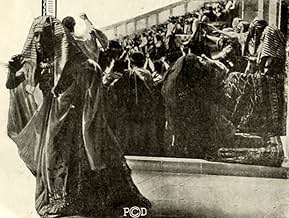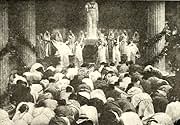IMDb-BEWERTUNG
6,1/10
642
IHRE BEWERTUNG
Füge eine Handlung in deiner Sprache hinzuTwo love triangles intersect in ancient Pompei.Two love triangles intersect in ancient Pompei.Two love triangles intersect in ancient Pompei.
Handlung
WUSSTEST DU SCHON:
- WissenswertesFor a while in the late summer and fall of 1913 there were two major Italian productions on this subject playing simultaneously in the US, this one produced by Ambrosio, and Jone ovvero gli ultimi giorni di Pompei (1913), produced by Pasquali.
- PatzerExtras are "killed" by falling pieces of a set during the explosion scene, then appear to either get back up or adjust themselves so that they won't be trampled by other extras.
- Alternative VersionenKino International Corp. copyrighted a version in 2000 with a piano music score compiled and arranged by Beatrice Jona Affron and performed by Martha Koeneman. It was produced for video by Bret Wood and runs 88 minutes.
- VerbindungenFeatured in Kino Europa - Die Kunst der bewegten Bilder: Where It All Began (1995)
- SoundtracksGiselle
Written by Adolphe Adam (as Adam)
Arranged by Beatrice Jona Affron
Performed by Martha Koeneman
Excerpts in the 2000 alternate version score
Ausgewählte Rezension
A young blind woman and her general misery provide the focus for this 1913 silent film. Her story is set against everyday life in Pompeii, just before the eruption of the famous volcano.
Visually, the film consists of staged sets, rather like modern stage plays. There is no camera movement. Actors mouth words we can't hear. The only sound is the music of a piano, provided on behalf of DVD viewers. The music varies in tone with tonal variations in the story. Alternating with the play and to assist the visuals, title cards convey a verbal sense of what will happen in the next scene.
Acting is very, very theatrical. When they move, the players don't walk, so much as they tiptoe across the stage, in a self-conscious and stagy manner. When there's conflict, the players overact, exaggerating both body movements and facial expressions. But that was how it was done back then. Costumes are elaborate, and at times ornate.
Vesuvius erupts in the final few minutes of the film. Lots of smoke, some soot, a change in the film's tint to reddish, falling pillars, and predictable histrionics of the players comprise the special effects.
Even aside from the simplicity of the special effects and the absence of sound, the film is not likely to appeal to modern audiences, if their purpose in watching films is to be entertained. For one thing, the film's pacing is very slow. Also, there's lots of filler material, like scenes wherein characters sit around feeding pigeons. And I found it hard to identify with any of the characters. They seem too thinly drawn and remote.
In its time, "The Last Days Of Pompeii" must have seemed like a grand spectacle. We are fortunate to have the film now, as a benchmark from which to compare contemporary films. Ergo, for those interested in the history of the cinema, and for those who want some perspective on modern film-making, this film is a fine choice.
Visually, the film consists of staged sets, rather like modern stage plays. There is no camera movement. Actors mouth words we can't hear. The only sound is the music of a piano, provided on behalf of DVD viewers. The music varies in tone with tonal variations in the story. Alternating with the play and to assist the visuals, title cards convey a verbal sense of what will happen in the next scene.
Acting is very, very theatrical. When they move, the players don't walk, so much as they tiptoe across the stage, in a self-conscious and stagy manner. When there's conflict, the players overact, exaggerating both body movements and facial expressions. But that was how it was done back then. Costumes are elaborate, and at times ornate.
Vesuvius erupts in the final few minutes of the film. Lots of smoke, some soot, a change in the film's tint to reddish, falling pillars, and predictable histrionics of the players comprise the special effects.
Even aside from the simplicity of the special effects and the absence of sound, the film is not likely to appeal to modern audiences, if their purpose in watching films is to be entertained. For one thing, the film's pacing is very slow. Also, there's lots of filler material, like scenes wherein characters sit around feeding pigeons. And I found it hard to identify with any of the characters. They seem too thinly drawn and remote.
In its time, "The Last Days Of Pompeii" must have seemed like a grand spectacle. We are fortunate to have the film now, as a benchmark from which to compare contemporary films. Ergo, for those interested in the history of the cinema, and for those who want some perspective on modern film-making, this film is a fine choice.
- Lechuguilla
- 10. Nov. 2006
- Permalink
Top-Auswahl
Melde dich zum Bewerten an und greife auf die Watchlist für personalisierte Empfehlungen zu.
Details
- Erscheinungsdatum
- Herkunftsland
- Sprachen
- Auch bekannt als
- The Last Days of Pompeii
- Produktionsfirma
- Weitere beteiligte Unternehmen bei IMDbPro anzeigen
- Laufzeit1 Stunde 28 Minuten
- Farbe
- Sound-Mix
- Seitenverhältnis
- 1.33 : 1
Zu dieser Seite beitragen
Bearbeitung vorschlagen oder fehlenden Inhalt hinzufügen

Oberste Lücke
By what name was Die letzten Tage von Pompeji (1913) officially released in Canada in English?
Antwort





















